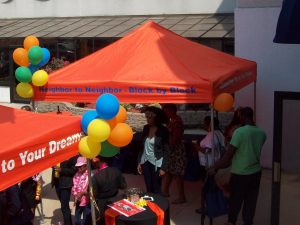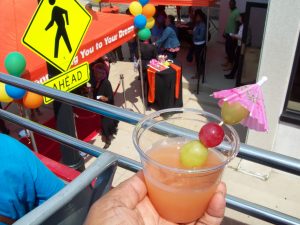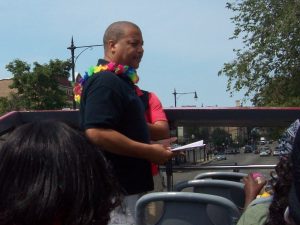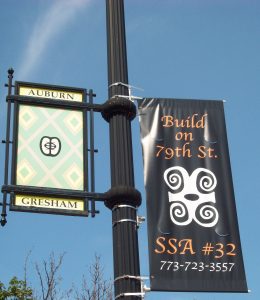Ride a Trolley, Sip a Cocktail, Change a Neighborhood
Reposted from the Urban Landlady
Published: August 10, 2017
Reposted from:
http://www.chicagonow.com/urban-landlady/2017/08/ride-a-trolley-sip-a-cocktail-change-a-neighborhood/
This past Saturday I went on a semi-annual trolley tour of the Auburn Gresham neighborhood sponsored by Greater Auburn-Gresham Development Corporation (GAGDC). The purpose of this booster tour was to show first-time homebuyers (and maybe even investors) great deals on houses in the area. I grew up there. My mom and dad worked there and my family went to church there, so this neighborhood is close to my heart and full of good memories for me. (Get your name on their mailing list to find out about the next tour.)
Auburn Gresham has had a long reputation of being a place where working class families could get established and has seen a so-called ethnic succession from German and Dutch to Irish to African American. Exporter of the original South Side Irish parade and best-known native Michael Flatley , this area is the long-time home to St. Sabina Church and revered-by-residents Father Michael Pfleger. In recent years it’s been seeing a lot of distress and I wanted to have a better understanding of the current situation and the future prospects.

21st Ward Alderman Howard Brookins was one of the guest speakers and made some great comments. He said what many people don’t realize is that when some neighborhoods go through a decline, it’s more of a commercial disinvestment--meaning that businesses leave. However, the housing stock (the residential infrastructure) remains strong. He mentioned that in certain areas like Auburn Gresham there are beautiful houses with “good bones,” sturdily built to stand the test of time. This was a concept way before it was a cable show.
There are architectural gems in Auburn Gresham and all over Chicago in places, you might not expect. That’s saying something in a city which has been an international architectural trendsetter for over a century. You don’t have to go to Oak Park. For example, Ald. Brookins said, most people have no clue there are Frank Lloyd Wright-designed houses in the Pullman neighborhood (don’t believe me? Check out the popular annual house tour each October).
“Residents know where the problem houses are on a block. When you know where the people causing the problems live, you just work on getting them out. And you don’t even have to pick up pitchforks and torches to do it.” 21st Ward Alderman Howard Brookins
This Auburn Gresham tour was aimed at 1st-time homebuyers and featured houses which needed only a moderate amount of work. But to digress, I have been on so-called “rehab tours” in other parts of the city geared toward investors where I have seen amazing things. When most people hear about a “gut rehab,” you assume it means that they just take out everything “down to the bare walls” (cabinets, doors, light fixtures, etc.). But can you imagine a gut rehab where they actually take out the walls, too? And the floors and the ceilings??? Sometimes stripping a place down to the walls is not enough. Modern lifestyles demand modern floor plans (bigger bedrooms, open kitchens, better traffic flow, MUCH more electrical access).

Cocktail umbrellas make everything better!
This type of rehab tour will take you into a building which has been stripped down to just a big, empty box. Four walls and a roof at the first stop. Then you will visit subsequent houses at progressive stages in the rehab process (the next one has floors and ceilings, the next one has floors/ceilings/walls, etc.). If you are an architecture/real estate nerd like myself this is one of the coolest things you will ever experience. Does not compare to seeing it on tv.
So I’m going out on a limb to put two and two together (low-priced properties with good bones and extreme gut rehabs). The beauty of this possibility is that in some recovering neighborhoods you can find properties for such a low price that you might be able to afford to do these modernizing gut rehabs and still end up with a good return on your investment. I’m talking 2-unit buildings for $30,000. And, even better, you can find some which don’t even really need such extensive work. This is a great opportunity for buy and hold investors (fancy talk for landlords) as well as homebuyers who want to save on gas and get closer to the great cultural and entertainment resources of Chicago.

GAGDC Executive Director Carlos Nelson all "lei-ed out."
Ald. Brookins teased the former Chicago residents in the audience who chose to move outside the city limits. He drew chuckles when he said, “There's nothing for you in the suburbs. Come on back home. Suburbs pay high property taxes. And you’re seeing that those schools are not as good as you thought they would be, right?” He encouraged migration back to Chicago by people with resources so some of the persistent issues can be addressed.
He talked about the common phenomenon where it only takes a few bad apples to bring a whole area down. He said, “Residents know where the problem houses are on a block. When you know where the people causing the problems live, you just work on getting them out. And you don’t even have to pick up pitchforks and torches to do it.”

Build on 79th Street, or buy what's already there
He gave some advice that I personally love and can identify with as a landlord and real estate investor. He said, “If there are problem people on your block who happen to rent, go to the landlord and suggest a better tenant. If you have a co-worker or a fellow church member who is looking for a place, connect them with that landlord. Or, start buying up some of these properties and start choosing some new tenants on your own.” He also suggested opening friendly lines of communication to help new residents adjust to the character of an area (i.e. please don’t barbecue on the front lawn)
If you are a Chicago resident who doesn’t live in or around any of these areas and is not interested in buying real estate then why does any of this matter to you? Because a rising tide lifts all boats. As we can see, crime and violence are contagious. When struggling communities are actively improved it strengthens the city overall. And you don’t have a take an action as dramatic as buying and rehabbing a property to make a difference. All I ask is that you take a look at our city through fresh eyes and recognize the inherent value. We can “save” this place. The road to recovery starts in our minds, our attitudes and our conversations. And once we look around and see how many silent-majority people are left who really care, it won’t be as hard as we think.